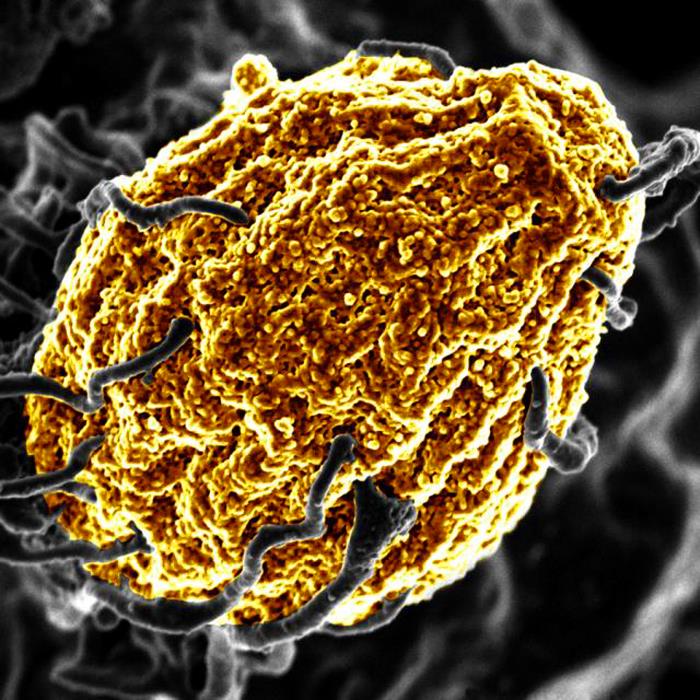
A new study has identified six ‘words’ that certain immune cells use to turn on defence genes, an important step towards discovering how the immune system coordinates itself to handle threats.
In addition, they discovered that using two of these words incorrectly can activate the wrong genes, resulting in the autoimmune disease known as Sjögren’s syndrome.
“Cells have evolved an immune response code, or language,” said senior author Alexander Hoffmann, a professor at UCLA. “We have identified some words in that language, and we know these words are important because of what happens when they are misused. Now we need to understand the meaning of the words, and we are making rapid progress. It’s as exciting as when archeologists discovered the Rosetta stone and could begin to read Egyptian hieroglyphs.”
Listening in on macrophages
Immune cells constantly assess their external environment, and communicate with signalling codons (‘words’) to tell the nucleus which genes to turn on in response to invading pathogens. These codons consist of a sequence of actions by a DNA binding protein that produces a word, like typing letters in sequence on a keyboard.
The researchers focused on words used by macrophages, which clear up harmful substances, pathogens and dead cells. ‘Listening’ to macrophages in healthy mice, they identified six specific codon-words that correlated to immune threats. They repeated this with mice that contained a mutation akin to Sjögren’s syndrome in humans to see if this disease is caused by the defective use of these words.
“Indeed, we found defects in the use of two of these words,” Prof Hoffmann said. “It’s as if instead of saying, ‘Respond to attacker down the street,’ the cells are incorrectly saying, ‘Respond to attacker in the house.'”
According to the researchers, the findings suggest that Sjögren’s doesn’t result from chronic inflammation as it has been thought to, but rather from a codon-word confusion that leads the body to attack itself. New treatments could focus on correcting the miscommunication.
Cracking the code
According to Prof Hoffman, the reason immune cells can mount a specific response to each pathogen is due to ‘signalling pathways’. These link receptor molecules on the immune cells with different defence genes. The transcription factor NFκB is one such pathway, acting as a central regulator of immune cell responses to pathogen threats.
“The macrophage is capable of responding to different types of pathogens and mounting different kinds of defences. The defence units—army, navy, air force, special operations—are mediated by groups of genes,” he said. “For each immune threat, the right groups of genes must be mobilised. That requires precise and reliable communication with those units about the nature of the threat. NFκB dynamics provide the communication code. We identified the words in this code, but we don’t yet fully understand how each defense unit interprets the various combinations of the codon-words.”
Calling up the wrong units can not only be ineffective but destructive as in Sjögren’s.
To crack the language, researchers studied how 12 000 cells communicated in response to 27 immune threat conditions. Based on possible arrangements of NFκB dynamics, they drew up a list of over 900 possible ‘words’, resembling three-letter words.
Then, using a telecommunications industry algorithm developed in the 1940s, they monitored the rate at which each of the potential words came up when macrophages responded to threats. They discovered that six specific dynamical features, or ‘words,’ were most frequently correlated with that response.
This would be like listening to a conversation and finding that certain three-letter words tend to be used, such as “the,” “boy,” “toy,” and “get,” but not “biy” or “bey,” explained lead author Adewunmi Adelaja, who earned his PhD in Hoffmann’s laboratory and is now pursuing his MD at UCLA.
The researchers found that teaching a machine learning algorithm the six words, it was able to recognise the stimulus when simulated cells were ‘talking’. They then explored what would happen if the computer only had five words available. They found that the algorithm made more errors in recognising the stimulus, which led the team to conclude that all six words are required for reliable cellular communication.
The scientists also used calculus to study the biochemical molecular interactions inside the immune cells that produce the words.
Source: UCLA
Journal information: Adewunmi Adelaja et al. Six distinct NFκB signaling codons convey discrete information to distinguish stimuli and enable appropriate macrophage responses, Immunity (2021). DOI: 10.1016/j.immuni.2021.04.011

